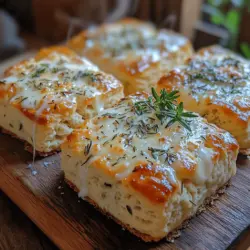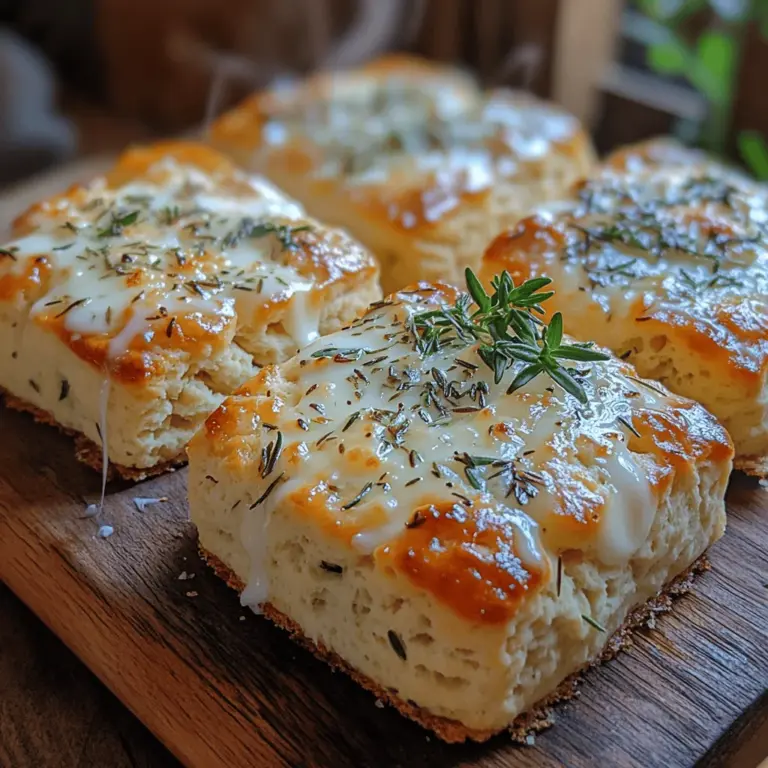Introduction
There’s something undeniably appealing about homemade scones. These delightful baked goods have long been a staple in tea time traditions around the world, offering a comforting balance of crispness and tenderness. While sweet scones often steal the spotlight, savory scones deserve just as much attention, especially when they are as delicious as savory ricotta herb scones.
This recipe transforms the traditional scone into a savory experience, featuring the creamy richness of ricotta cheese and a medley of fresh herbs. The unique flavor profile of these scones is a delightful departure from the norm, making them a perfect accompaniment to soups, salads, or simply enjoyed on their own with a pat of butter. The appeal of savory ricotta herb scones lies in their versatility; they can be served as an elegant appetizer, a satisfying snack, or even as a breakfast option that will leave you feeling nourished and satisfied.
In crafting this recipe, we emphasize the importance of using fresh herbs and high-quality ingredients. These elements not only enhance the flavor but also elevate an otherwise simple recipe into something truly special. Fresh herbs like rosemary and thyme bring aromatic notes that brighten each bite, while ricotta and Parmesan add creaminess and depth. Together, they create a scone that will impress both family and friends alike—perfect for gatherings or quiet mornings at home.
Understanding the Ingredients
To create the perfect savory ricotta herb scones, it’s crucial to understand the role and characteristics of each ingredient. Let’s delve into the specifics of what makes this recipe shine.
Ricotta Cheese
Ricotta cheese is the star ingredient in this scone recipe, contributing a soft, creamy texture that balances out the drier components. Unlike other cheeses, ricotta has a mild flavor that allows it to blend beautifully with the other ingredients without overpowering them. Nutritionally, ricotta is a great source of protein and calcium, making these scones a wholesome choice. When selecting ricotta, opt for fresh varieties for the best flavor—look for those that are creamy and free of excess liquid.
Unsalted Butter
Unsalted butter plays a pivotal role in baking, particularly in scones where it adds richness and tenderness. The fat in the butter coats the flour particles, inhibiting gluten formation and resulting in a lighter, flakier texture. Using unsalted butter also allows you to control the saltiness of the final product. For this recipe, ensure your butter is cold and cut into small cubes before incorporating it into the dry ingredients, as this will help achieve that flaky texture we all love in scones.
Fresh Herbs
Fresh herbs are essential in this savory scone recipe, providing vibrant flavors that elevate the dish. Rosemary and thyme are particularly well-suited for this recipe; their earthy notes complement the creamy ricotta perfectly. Fresh herbs not only enhance flavor but also add nutritional benefits—packed with antioxidants and vitamins, they can contribute to overall health. When using fresh herbs, make sure to chop them finely to distribute their flavor evenly throughout the dough.
Garlic Powder
Garlic powder is a secret ingredient that adds a subtle depth of flavor to the scones. While fresh garlic could be used, garlic powder offers a milder taste and blends seamlessly into the dough. It enhances the savory profile without overwhelming the other ingredients, making it a perfect addition to work alongside the herbs.
All-Purpose Flour
All-purpose flour serves as the foundation of any scone recipe, providing structure and stability. It’s essential to measure the flour correctly to avoid overly dense or dry scones. For the best results, spoon the flour into your measuring cup and level it off with a knife rather than scooping directly from the bag. This ensures you’re using the right amount without packing the flour down.
Baking Powder
Baking powder is the leavening agent in this recipe, responsible for helping the scones rise. It creates air pockets in the dough, resulting in a light and fluffy texture. To ensure the effectiveness of your baking powder, check the expiration date before use. It’s also best to sift it with the flour to distribute it evenly throughout the mixture.
Parmesan Cheese
Parmesan cheese adds an extra layer of flavor complexity to the scones. Its sharp, nutty profile complements the creaminess of the ricotta while enhancing the overall savoriness. Grate fresh Parmesan for the best results, as pre-packaged shredded cheese often contains additives that can affect melting and flavor.
Salt and Black Pepper
Finally, seasoning with salt and black pepper is crucial in enhancing the overall taste of the scones. Salt brings out the natural flavors of the ingredients and balances the richness of the cheese, while black pepper adds a subtle heat that rounds out the flavor profile. Be sure to season thoughtfully—too much salt can overpower the other flavors, while too little can leave the scones bland.
Preparation Steps for Savory Ricotta Herb Scones
Now that we’ve covered the essential ingredients, let’s dive into the preparation process. These steps will guide you through creating your savory ricotta herb scones, ensuring that you achieve the perfect texture, flavor, and presentation.
Preheating the Oven and Preparing the Baking Sheet
Start by preheating your oven to 400°F (200°C). This temperature is ideal for baking scones, allowing them to rise properly while developing a golden-brown exterior. As the oven heats, line a baking sheet with parchment paper or a silicone baking mat. This preparation step not only prevents sticking but also aids in even baking.
Importance of Oven Temperature in Achieving the Perfect Texture
Maintaining the right oven temperature is crucial for achieving the desired texture in your scones. If the oven is too hot, the scones may rise too quickly, resulting in a dense interior. Conversely, if the oven is too cool, the scones may spread instead of rising. An accurate oven thermometer can help ensure that your oven is at the correct temperature before you place the scones inside.
Mixing Wet Ingredients: Techniques to Ensure a Smooth Blend
In a large mixing bowl, combine the ricotta cheese, cold unsalted butter, and any wet ingredients specified in your recipe (such as milk or an egg, if used). Use a pastry cutter or your fingers to blend the butter into the ricotta until the mixture resembles coarse crumbs. This technique ensures that the fat is evenly distributed throughout the mixture, which is key for creating a flaky texture.
Incorporating Herbs and Spices: Tips for Maximizing Flavor
Once your wet mixture is ready, it’s time to incorporate the fresh herbs and garlic powder. Ensure the herbs are finely chopped before adding them to the mixture. Gently fold the herbs into the ricotta mixture, taking care not to overmix, as this can lead to tough scones. The goal is to evenly distribute the herbs while maintaining a light, airy texture.
Combining Dry Ingredients: Avoiding Common Pitfalls in Baking
In a separate bowl, whisk together the all-purpose flour, baking powder, salt, black pepper, and grated Parmesan cheese. Sifting the dry ingredients before mixing helps to aerate the flour and remove any lumps. As you combine the dry ingredients, be cautious not to overmix. Overworking the dough can develop gluten, leading to dense scones instead of light and fluffy ones.
Forming the Dough: Understanding Dough Consistency and Handling
Once the dry ingredients are mixed, make a well in the center and pour in the wet mixture. Stir gently with a spatula or wooden spoon until the dough starts to come together. The consistency should be slightly sticky but manageable. If the dough feels too wet, you can add a small amount of flour, but be careful not to add too much as this can alter the texture.
Shaping the Scones: Techniques for Uniformity and Presentation
Transfer the dough onto a lightly floured surface and gently pat it into a round disc, about 1-inch thick. Use a sharp knife or a dough cutter to slice the disc into wedges, or use a round biscuit cutter to create perfectly uniform scones. Place the shaped scones on the prepared baking sheet, spacing them about an inch apart to allow for expansion during baking. If desired, brush the tops with a bit of milk or an egg wash for a beautiful golden finish.
With these steps completed, you’re well on your way to enjoying the delightful flavors of savory ricotta herb scones. The next part of this recipe will guide you through the baking process, ensuring that you achieve the perfect texture and taste that will leave everyone wanting more.

Preparing for Baking: The Role of Milk in Creating a Golden Crust
Before you slide those savory ricotta herb scones into the oven, let’s talk about a crucial ingredient: milk. The type of milk you choose can significantly influence the final texture and appearance of your scones. Whole milk is often recommended for its higher fat content, which contributes to a richer flavor and a beautifully golden crust. When brushing the tops of your scones with milk, you not only enhance their color but also create a slight sheen that makes them visually appealing.
As the scones bake, the milk interacts with the heat, aiding in the Maillard reaction, which is responsible for that golden-brown crust. If you prefer a lighter option, you can use skim or low-fat milk, but keep in mind that the flavor may not be as rich. For a dairy-free alternative, consider using almond milk or oat milk, although this may alter the texture slightly. Whichever milk you choose, make sure it’s at room temperature when you apply it to the scone tops, as this helps with even baking.
Baking: Indicators of Doneness and Texture to Look For
Once your scones are in the oven, keep an eye on them as they begin to bake. The ideal baking temperature for savory scones is around 400°F (200°C). After about 20 minutes, you should start checking for doneness. The scones should have risen beautifully and achieved a golden brown color on the tops. A toothpick inserted into the center should come out clean, indicating that the scones are fully cooked inside.
Another way to assess doneness is by gently tapping the bottom of a scone; it should sound hollow. The texture of the scone should be firm yet tender, with a slightly crumbly interior that melts in your mouth. If the scones are still doughy after the recommended baking time, give them an additional 2-3 minutes. Remember, every oven is different, so adjust your baking time accordingly to achieve the perfect scone.
Serving Suggestions
Ideal Pairings for Savory Ricotta Herb Scones
Savory ricotta herb scones are incredibly versatile and can be enjoyed in various ways. They make an excellent addition to any meal, whether served at breakfast, brunch, or as a side dish. For a classic pairing, serve your scones warm with a pat of high-quality butter. The rich, creamy texture of the butter complements the flaky scones perfectly.
You could also serve them with fruit jams or preserves. While the scones themselves are savory, a touch of sweetness from berry jams can create a delightful contrast. Consider options like fig jam or a homemade garlic herb spread, which can enhance the overall flavor profile.
Pairing with Soups or Salads for a Complete Meal
For a heartier meal, pair your savory scones with a warm soup or a fresh salad. A creamy tomato basil soup or a light vegetable broth complements the herbaceous notes of the scones beautifully. Alternatively, a crisp garden salad with a tangy vinaigrette can balance the richness of the scones, making for a satisfying meal.
Creative Serving Ideas for Gatherings or Brunches
If you’re hosting a gathering or brunch, consider serving the scones on a platter alongside a variety of toppings for guests to customize their experience. This could include an assortment of cheeses, such as goat cheese or sharp cheddar, along with sliced cured meats for a touch of elegance. You can also create a mini charcuterie board with nuts, olives, and seasonal fruits, making the scones an integral part of a delightful spread.
Nutritional Information
When indulging in savory ricotta herb scones, it’s important to be mindful of their nutritional content. Each scone typically contains around 200 calories, depending on the size and specific ingredients used. Here’s a breakdown of the nutritional values per serving:
– Calories: 200
– Fats: 10g (of which saturated fats are around 5g)
– Proteins: 6g
– Carbohydrates: 25g (with dietary fiber approximately 1g)
Benefits of Key Ingredients in a Balanced Diet
Ricotta cheese is a primary ingredient in these scones and is a great source of protein and calcium, making it beneficial for bone health. The herbs added to the mixture not only enhance flavor but also provide various vitamins and antioxidants. Whole grain flour, if used, offers more fiber than refined flour, promoting digestive health.
Incorporating these scones into a balanced diet is possible by being mindful of portion sizes and pairing them with nutrient-dense foods like salads and vegetables.
Variations and Customizations
Ideas for Ingredient Substitutions
One of the joys of baking is experimenting with different flavors and ingredients. If you want to switch things up, consider substituting the ricotta with other cheeses such as feta or goat cheese for a tangy twist. Alternatively, you can use cottage cheese for a lighter option, although this may change the texture slightly.
Alternative Cheeses or Herbs for Different Flavor Profiles
Explore different flavor profiles by altering the herbs you use. Instead of thyme and rosemary, try dill and chives for a fresh, spring-like taste. Incorporating sun-dried tomatoes or spinach can also add a pop of color and flavor to your scones, transforming them into a delightful Mediterranean treat.
Gluten-Free Options Using Alternative Flours
For those avoiding gluten, you can create a gluten-free version of these scones by substituting all-purpose flour with a gluten-free blend. Be sure to include a binding agent like xanthan gum to help maintain the scone structure. Almond flour or oat flour are also great choices that provide unique flavors while keeping the scones light.
Adjusting the Recipe for Dietary Preferences (Vegan, Low-Carb)
If you’re looking for a vegan option, substitute the ricotta cheese with a plant-based alternative, such as tofu blended with nutritional yeast for a cheesy flavor. Replace the milk with almond or soy milk and use a flaxseed egg as a binding agent. For a low-carb version, consider using coconut flour or almond flour, adjusting the liquid content accordingly, as these flours absorb moisture differently than regular flour.
Storing and Reheating Scones
Best Practices for Storing Scones to Maintain Freshness
To keep your savory ricotta herb scones fresh, store them in an airtight container at room temperature for up to two days. If you want to keep them longer, consider freezing them. To freeze, wrap each scone individually in plastic wrap and place them in a freezer-safe bag. They can be frozen for up to three months.
Methods for Reheating Scones Without Losing Texture
When it’s time to enjoy your scones again, the best way to reheat them is in the oven. Preheat your oven to 350°F (175°C) and place the scones on a baking sheet. Heat for about 10-15 minutes until warmed through. This method helps restore the flaky texture and ensures they don’t become soggy. If you’re in a hurry, you can also reheat them in the microwave for 15-20 seconds, but be cautious not to overheat, as this can make them tough.
Conclusion
Making savory ricotta herb scones is a rewarding and enjoyable baking experience that brings together simple ingredients to create something truly delicious. The ease of preparation and the satisfaction of enjoying warm, flaky scones fresh from the oven is unparalleled. Don’t hesitate to experiment with different flavors and ingredients, making this recipe your own.
Whether you enjoy these scones for breakfast, brunch, or as a delightful side for dinner, they are sure to impress family and friends. Remember, the joy of baking lies not only in the final product but also in the process and the memories created along the way. So gather your ingredients, preheat your oven, and embark on this culinary adventure! Happy baking!


